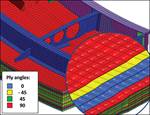Software update: Materials database support for simulation/analysis
Another piece of the software integration puzzle in the aerospace world is finding ways and means to incorporate into the design process data from existing materials databases.
Another piece of the software integration puzzle in the aerospace world is finding ways and means to incorporate into the design process data from existing materials databases. That is the mission of Granta Design’s (Cambridge, U.K.) 2014 release of its Composites Design Data Module. The Module provides traceable design data from the Advanced General Aviation Transport Experiment (AGATE) shared database project (initiated by NASA in 1995) and continuing work in that arena by the National Center for Advanced Materials (NCAMP), housed at the National Institute for Aviation Research (Wichita State University, Wichita, Kan.). Granta’s database software includes material property data for constituents, intermediates, and processing steps used to generate more than 600 laminates.
Phase I of the company’s composite data management project resulted in a validated solution for managing a complete materials data lifecycle. Called GRANTA MI, this solution reportedly ensures that information is easily accessible, traceable, and available for use in further analysis and simulation. It also allows for the inhouse composite materials information to be combined with reference data from Granta’s Composite Design Data Module. In Phase II, the aerospace, energy and defense organizations that make up the Material Data Management Consortium, which works to provide additional tools for simulation and multiscale modeling, will store metadata to describe not just the sources of material property data, but, for example, parameter settings and details about how and when simulations were run.
Editor's Note: This short artticle is a sidebar to a feature article titled "Software update: Sumulation saves," which can bee accessed by clicking on it's title under "Editor's Picks," at top right.
Related Content
-
Plant tour: Spirit AeroSystems, Belfast, Northern Ireland, U.K.
Purpose-built facility employs resin transfer infusion (RTI) and assembly technology to manufacture today’s composite A220 wings, and prepares for future new programs and production ramp-ups.
-
Plant tour: Joby Aviation, Marina, Calif., U.S.
As the advanced air mobility market begins to take shape, market leader Joby Aviation works to industrialize composites manufacturing for its first-generation, composites-intensive, all-electric air taxi.
-
Welding is not bonding
Discussion of the issues in our understanding of thermoplastic composite welded structures and certification of the latest materials and welding technologies for future airframes.









.jpg;maxWidth=300;quality=90)
